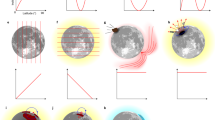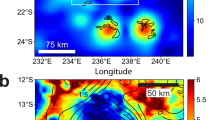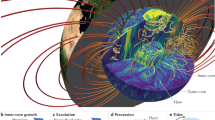Abstract
Magnetizations within lunar rocks indicate that the ancient Moon produced an internally generated magnetic field1,2,3,4. Yet the long-lived field intensities of 40–120 μT inferred for the ancient Moon1 are unsustainably high and cannot be reconciled with the small lunar core size, requiring three orders of magnitude more energy than deemed possible5. Here, we report that a 1 Gyr protracted foundering of cool, dense Ti-rich material initially emplaced at shallow depths can generate the high-intensity magnetic fields (≥50 μT) preserved within returned lunar samples through temporary episodes of elevated superadiabatic heat flow (≥50 mW m−3) out of the lunar core. Our results can simultaneously explain both the high magnitude and large-scale variability in field intensities before at least 3.5 Gyr ago1 while still permitting lower fields to have persisted thereafter.
This is a preview of subscription content, access via your institution
Access options
Access Nature and 54 other Nature Portfolio journals
Get Nature+, our best-value online-access subscription
$29.99 / 30 days
cancel any time
Subscribe to this journal
Receive 12 digital issues and online access to articles
$119.00 per year
only $9.92 per issue
Buy this article
- Purchase on Springer Link
- Instant access to full article PDF
Prices may be subject to local taxes which are calculated during checkout


Similar content being viewed by others
Data availability
All data to reproduce the results of this study are provided in the Supplementary Information or references, or are available at Harvard Dataverse: doi:10.7910/DVN/WWETNX. Source data are provided with this paper.
Code availability
The code used to produce the numerical results discussed in the text is available from the corresponding author on reasonable request.
References
Weiss, B. P. & Tikoo, S. M. The lunar dynamo. Science 346, 1246753 (2014).
Garrick-Bethell, I., Weiss, B. P., Shuster, D. L. & Buz, J. Early lunar magnetism. Science 323, 356–359 (2009).
Shea, E. K. et al. A long-lived lunar core dynamo. Science 335, 453–456 (2012).
Suavet, C. et al. Persistence and origin of the lunar core dynamo. Proc. Natl Acad. Sci. USA 110, 8453–8458 (2013).
Evans, A. J., Tikoo, S. M. & Andrews‐Hanna, J. C. The case against an early lunar dynamo powered by core convection. Geophys. Res. Lett. 45, 98–107 (2018).
Laneuville, M. et al. A long-lived lunar dynamo powered by core crystallization. Earth Planet. Sci. Lett. 401, 251–260 (2014).
Evans, A. J., Zuber, M. T., Weiss, B. P. & Tikoo, S. M. A wet, heterogeneous lunar interior: lower mantle and core dynamo evolution. J. Geophys. Res. Planets 119, 1061–1077 (2014).
Scheinberg, A., Soderlund, K. M. & Schubert, G. Magnetic field generation in the lunar core: the role of inner core growth. Icarus 254, 62–71 (2015).
Stegman, D. R., Jellinek, A., Zatman, S., Baumgardner, J. R. & Richards, M. A. An early lunar core dynamo driven by thermochemical mantle convection. Nature 421, 143–146 (2003).
Zhang, N., Parmentier, E. M. & Liang, Y. A 3-D numerical study of the thermal evolution of the Moon after cumulate mantle overturn: the importance of rheology and core solidification. J. Geophys. Res. Planets 118, 1789–1804 (2013).
Scheinberg, A. L., Soderlund, K. M. & Elkins-Tanton, L. T. A basal magma ocean dynamo to explain the early lunar magnetic field. Earth Planet. Sci. Lett. 492, 144–151 (2018).
Bars, M. L., Wieczorek, M. A., Karatekin, Ö., Cebron, D. & Laneuville, M. An impact-driven dynamo for the early Moon. Nature 479, 215–218 (2011).
Dwyer, C. A., Stevenson, D. J. & Nimmo, F. A long-lived lunar dynamo driven by continuous mechanical stirring. Nature 479, 212–214 (2011).
Stys, C. & Dumberry, M. A past lunar dynamo thermally driven by the precession of its inner core. J. Geophys. Res. Planets 125, e2020JE006396 (2020).
Hood, L. L. & Artemieva, N. A. Antipodal effects of lunar basin-forming impacts: initial 3D simulations and comparisons with observations. Icarus 193, 485–502 (2008).
Oran, R., Weiss, B. P., Shprits, Y., Miljković, K. & Tóth, G. Was the moon magnetized by impact plasmas? Sci. Adv. 6, eabb1475 (2020).
Tikoo, S. M. et al. Decline of the lunar core dynamo. Earth Planet. Sci. Lett. 404, 89–97 (2014).
Buz, J. et al. Magnetism of a very young lunar glass. J. Geophys. Res. Planets 120, 1720–1735 (2015).
Mighani, S. et al. The end of the lunar dynamo. Sci. Adv. 6, eaax0883 (2020).
Cournède, C., Gattacceca, J. & Rochette, P. Magnetic study of large Apollo samples: possible evidence for an ancient centered dipolar field on the Moon. Earth Planet. Sci. Lett. 331, 31–42 (2012).
Tarduno, J. A. et al. Absence of a long-lived lunar paleomagnetosphere. Sci. Adv. 7, eabi7647 (2021).
Elkins-Tanton, L. T., Burgess, S. & Yin, Q.-Z. The lunar magma ocean: reconciling the solidification process with lunar petrology and geochronology. Earth Planet. Sci. Lett. 304, 326–336 (2011).
Warren, P. H. The magma ocean concept and lunar evolution. Annu. Rev. Earth Planet. Sci. 13, 201–240 (1985).
Snyder, G. A., Taylor, L. A. & Neal, C. R. A chemical model for generating the sources of mare basalts: combined equilibrium and fractional crystallization of the lunar magmasphere. Geochim. Cosmochim. Acta 56, 3809–3823 (1992).
Zhang, N., Dygert, N., Liang, Y. & Parmentier, E. M. The effect of ilmenite viscosity on the dynamics and evolution of an overturned lunar cumulate mantle. Geophys. Res. Lett. 44, 6543–6552 (2017).
Khan, A., Connolly, J. A. D., Pommier, A. & Noir, J. Geophysical evidence for melt in the deep lunar interior and implications for lunar evolution. J. Geophys. Res. Planets 119, 2197–2221 (2014).
Glatzmaier, G. A., Coe, R. S., Hongre, L. & Roberts, P. H. The role of the Earth’s mantle in controlling the frequency of geomagnetic reversals. Nature 401, 885–890 (1999).
Thébault, E. et al. International Geomagnetic Reference Field: the 12th generation. Earth Planets Space 67, 79 (2015).
Christensen, U. R. Dynamo scaling laws and applications to the planets. Space Sci. Rev. 152, 565–590 (2010).
Christensen, U. R., Holzwarth, V. & Reiners, A. Energy flux determines magnetic field strength of planets and stars. Nature 457, 167–169 (2009).
Turcotte, D. & Schubert, G. in Geodynamics Ch. 6 (Cambridge Univ. Press, 2014).
Wyatt, B. A. The melting and crystallisation behaviour of a natural clinopyroxene–ilmenite intergrowth. Contrib. Miner. Petrol. 61, 1–9 (1977).
Zhao, Y., Vries, J., de, Berg, A. P., van den, Jacobs, M. H. G. & Westrenen, W.van The participation of ilmenite-bearing cumulates in lunar mantle overturn. Earth Planet. Sci. Lett. 511, 1–11 (2019).
Huppert, H. E. The propagation of two-dimensional and axisymmetric viscous gravity currents over a rigid horizontal surface. J. Fluid Mech. 121, 43 (1982).
Dufek, J. & Bergantz, G. W. Lower crustal magma genesis and preservation: a stochastic framework for the evaluation of basalt–crust interaction. J. Petrol. 46, 2167–2195 (2005).
Turcotte, D. L. & Oxburgh, E. R. Lunar convection. J. Geophys. Res. 75, 6549–6552 (1970).
Schubert, G., Turcotte, D. L. & Olson, P. in Mantle Convection in the Earth and Planets 586–632 (Cambridge Univ. Press, 2001).
Harada, Y. et al. The deep lunar interior with a low-viscosity zone: revised constraints from recent geodetic parameters on the tidal response of the Moon. Icarus 276, 96–101 (2016).
Strang, G. Computational Science and Engineering (Wellesley–Cambridge, 2007).
Stevenson, D. J., Spohn, T. & Schubert, G. Magnetism and thermal evolution of the terrestrial planets. Icarus 54, 466–489 (1983).
Acknowledgements
We acknowledge J.T. Keane and J.I. Schneiderman for insightful discussions. A.J.E. was supported by NASA grant 80NSSC20K0861.
Author information
Authors and Affiliations
Contributions
A.J.E. conceived this study, developed the finite-difference model for heat transfer and calculated surface magnetic field intensities. S.M.T. prepared the modern lunar palaeomagnetic dataset and summary. Both authors contributed to preparation of the manuscript and the conclusions presented in this work.
Corresponding author
Ethics declarations
Competing interests
The authors declare no competing interests.
Peer review information
Nature Astronomy thanks Julien Aubert and the other, anonymous, reviewer(s) for their contribution to the peer review of this work.
Additional information
Publisher’s note Springer Nature remains neutral with regard to jurisdictional claims in published maps and institutional affiliations.
Extended data
Extended Data Fig. 1 Inferred paleointensities of the core dynamo throughout lunar history as recorded by returned samples.
Modern, high-fidelity measurements (grey) are shown alongside Apollo-era paleomagnetic data (orange). Circles indicate paleointensity determinations and triangles indicate upper limit values for paleointensities. Modern data indicate a lunar dynamo capable of strong surface magnetic fields of approximately 40–100 μT prior to 3.56 Ga (cyan) and weak surface fields of less than 5 μT after ~3.2 Ga (magenta), with a transition period in between (indicated by dashed vertical lines). For reference, the average present-day magnetic field intensity for Earth is 30 μT.
Extended Data Fig. 2 Timescale of lateral spreading of foundered diapirs atop the lunar core.
Solid lines indicate the timescale of lateral spreading of a single foundered diapir (d=1) with melt viscosities of 102 Pa s (black) and 104 Pa s (magenta). Dashed line shows lateral spreading timescale for d equidistant foundered diapirs with a viscosity of 102 Pa s and of total volume equivalent to a foundered diapir of radius 100 km.
Supplementary information
Supplementary Information
Supplementary text, Figs. 1–3, Tables 1–5 and refs. 41–65.
Source data
Source Data Fig. 1
Magnetic field intensity (μT) as a function of diapir radius (km) for Fig. 1.
Source Data Fig. 2
Delineations of regions shown in Fig. 2.
Source Data Extended Data Fig. 1
Palaeomagnetic data for Extended Data Fig. 1.
Source Data Extended Data Fig. 2
Lateral spreading timescales shown in Extended Data Fig. 2.
Rights and permissions
About this article
Cite this article
Evans, A.J., Tikoo, S.M. An episodic high-intensity lunar core dynamo. Nat Astron 6, 325–330 (2022). https://doi.org/10.1038/s41550-021-01574-y
Received:
Accepted:
Published:
Issue Date:
DOI: https://doi.org/10.1038/s41550-021-01574-y
This article is cited by
-
Thermodynamic properties of geikielite (MgTiO3) and ilmenite (FeTiO3) derived from vibrational methods combined with Raman and infrared spectroscopic data
Physics and Chemistry of Minerals (2022)



